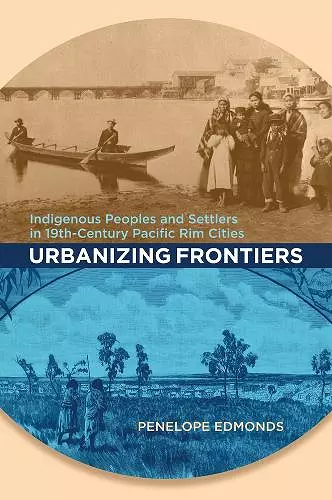Urbanizing Frontiers
Indigenous Peoples and Settlers in 19th-Century Pacific Rim Cities
Format:Hardback
Publisher:University of British Columbia Press
Published:15th Jan '10
Currently unavailable, and unfortunately no date known when it will be back

An innovative study that reconceptualizes the frontier as urban space by comparing the lives of Indigenous peoples and settlers in two colonial cities.
This book explores the lives of Indigenous peoples and settlers and compares the emergence of racial boundaries in two Pacific Rim cities – Victoria, British Columbia, and Melbourne, Australia.Colonial frontiers were not confined to the bush, backwoods, or borderlands. Early towns and cities in the far reaches of empire were crucial to the settler colonial project. The experiences of Indigenous peoples in these urbanizing frontiers have been overshadowed by triumphant narratives of European progress.
Urbanizing Frontiers explores the lives of Indigenous peoples and newcomers in two Pacific Rim cities – Victoria, British Columbia, and Melbourne, Australia. Built on Indigenous lands and overtaken by gold rushes, these cities emerged between 1835 and 1871 in significantly different locations, yet both became cross-cultural and ultimately segregated sites of empire, where bodies and spaces were rapidly transformed, sometimes in violent ways.
This innovative, interdisciplinary study reconceptualizes the frontier as urbanizing space by charting the development of the settler-colonial city.
Urbanizing Frontiers is a fine example of comparative colonial history. This sort of history requires research in multiple locations often separated by vast distances, engagement with the historiographical contours of at least two countries, and a conceptual language to bridge them. ...[it shows] rich and compelling evidence or the insightful analysis which is developed with reference to postcolonial, feminist and spatial theory.... Urbanizing Frontiers is a sophisticated monograph, carefully crafted and impressive in scope. It deserves a wide readership in indigenous studies, colonial history, urban history and historical geography, while also making an important and timely contribution to both Australian and Canadian history.
-- Fances Steel, University of Wollongong * Aboriginal History, Vol 35 *Edmonds argues for a redefinition of perhaps the most contested idea in settler colonial historiography: that of the frontier….and offers a devastating indictment of the urban biopolitics of settler colonialism and their effect on Indigenous society.
-- Edward Cavanagh, University of the Witwatersrand * Settler Colonial Studies, Issue 1 *Taking as her case studies Victoria on Canada’s west coast and Melbourne, Australia, Edmonds makes a compelling case for the ways in which urban and indigenous histories are deeply entwined..[with] insightful placements of the potlatch and the corroboree alongside the grid and the picturesque ... the urban stories she tells are rich, complex, and densely critical ... Urbanizing Frontiers is an outstanding contribution to the nascent literature on urban colonialism and indigenous peoples. -- Coll Thrush, University of British Columbia * Pacific Historical Review *
This is an important book, a must read not only for scholars in Native studies, but for urban historians as well. Indeed, I found myself excitingly quoting from it and footnoting it while preparing a manuscript before I could sit down and systematically read it for the purposes of this review ... One of the strengths of this book, indeed, is Edmonds’ nuanced analysis of gender. We not only see indigenous women in a wide variety of roles in both places from oyster traders to victims of sexual abuse, we also see how critical gender was in the discursive construction of place -- Jay Gitlin, Yale University * Australian Historical Studies *
Urbanizing Frontiers sheds much-needed light on the spatial mobility of the developing settler colonial city where ‘mutual, albeit uneven, interactions, of colonization and Indigenization were, for a short time part of the tenor of the early settler-colonial landscape’. Edmonds is truly interdisciplinary in her research and conceptualisation of these two sites and she makes an important contribution to the understanding of Australian and Canadian history, as well as the other discourses of colonialism, race and urban geography. -- Tiffany Shellam * History Australia *
An excellent work of comparative colonial history...the casual reader of British Columbian or Australian history as well as the academic of urban studies, policy, urban geography, colonial, gender and race history should consider reading this book. -- Omeasoo Butt, University of Saskatchewan * Canadian Journal of History / Annales canadiennes d'histoire, Vol. XLVlI, Autumn/automne 20
ISBN: 9780774816212
Dimensions: unknown
Weight: 520g
328 pages